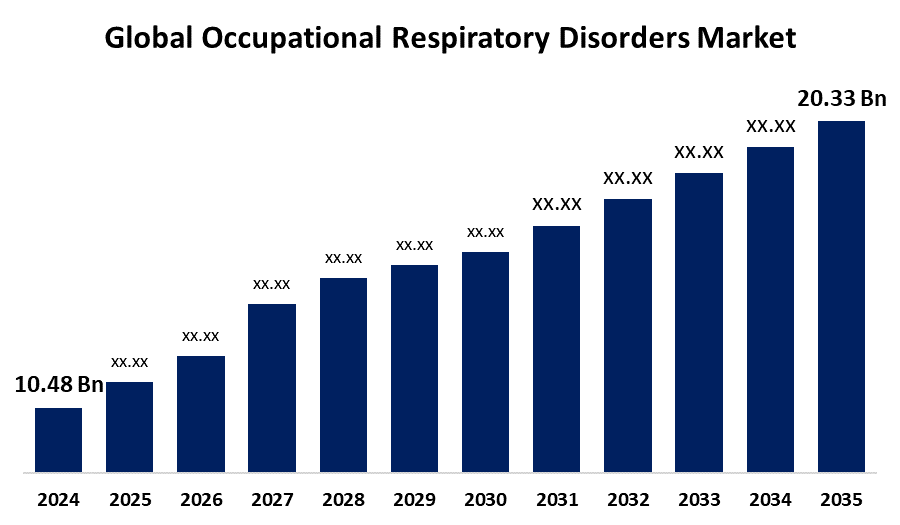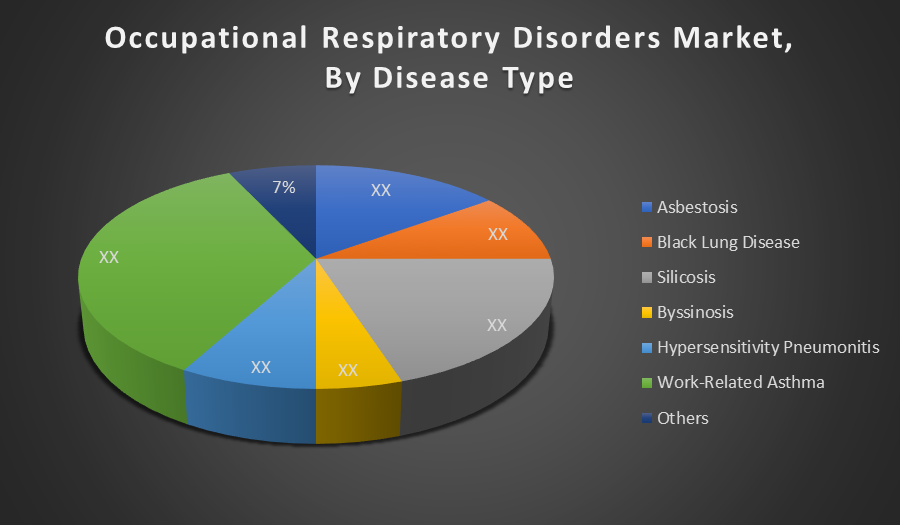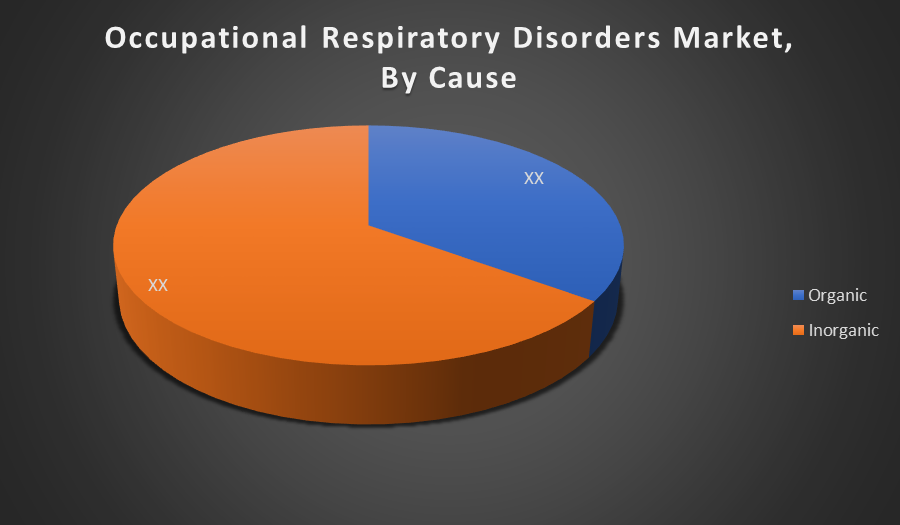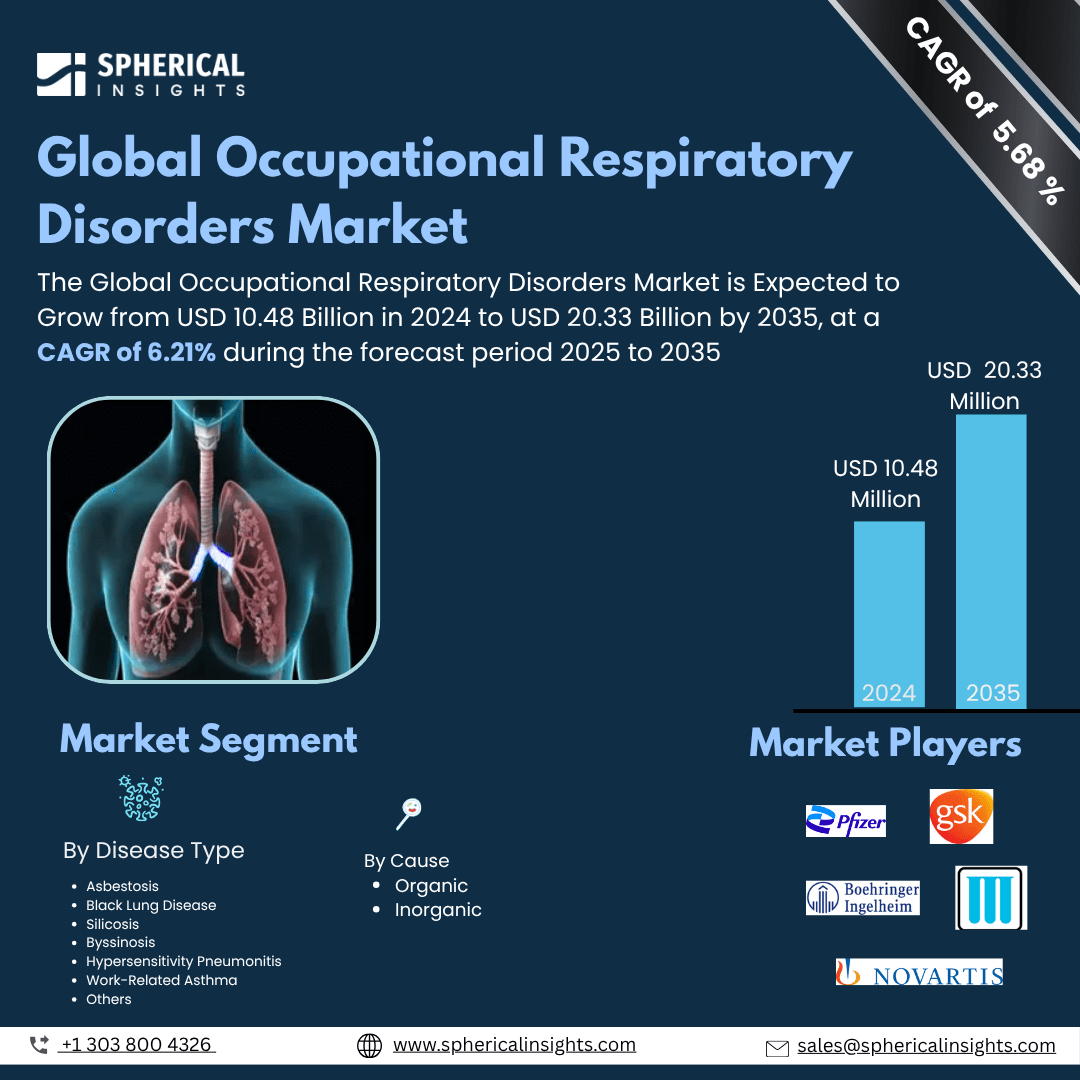- As per Spherical Insights & Consulting, The Global Occupational Respiratory Disorders Market Size is Expected to Grow from USD 10.48 Billion in 2024 to USD 20.33 Billion by 2035, at a CAGR of 6.21% during the forecast period 2025 to 2035, owing to the launch of new therapies in the market and the rise in the number of cases.
- The leading Occupational Respiratory Disorders Market Companies such as Pfizer, GlaxoSmithKline, AstraZeneca, Boehringer Ingelheim, Novartis, Sanofi, Merck & Co., Teva Pharmaceutical, Cipla, Mylan, Sun Pharmaceutical, Johnson & Johnson, Bayer, Roche, Eli Lilly, and Others.
Occupational Respiratory Disorders Treatment Market: Understanding and Treatment Algorithm:
Occupational respiratory disorders are lung diseases caused by exposure to harmful substances in the workplace, such as dust, chemicals, fumes, or allergens. Common conditions include work-related asthma, silicosis, and asbestosis. These disorders can lead to chronic breathing problems and require prevention, early diagnosis, and appropriate medical treatment.

Occupational Respiratory Disorders Diagnosis:
Diagnosis of occupational respiratory disorders involves evaluating a patient’s medical history, workplace exposure, physical symptoms, and lung function through spirometry, chest X-rays, or CT scans. Additional tests may include allergy testing or bronchodilator response. Accurate diagnosis helps determine the specific disorder and guides effective treatment and workplace intervention.
Occupational Respiratory Disorders Treatment
Treatment of occupational respiratory disorders includes removing or reducing exposure to harmful workplace substances, medication to manage symptoms, and pulmonary rehabilitation. Common therapies include inhaled bronchodilators, corticosteroids, and oxygen therapy. Early intervention and ongoing monitoring are essential to prevent disease progression and improve quality of life.
Occupational Respiratory Disorders Epidemiology
The disease epidemiology covered in the report provides historical as well as forecasted epidemiology segmented by Total Diagnosed Incident Population of Occupational Respiratory Disorders, Gender-specific Diagnosed Incidence of Occupational Respiratory Disorders, Type-specific Diagnosed Incidence of Occupational Respiratory Disorders, Age-specific Diagnosed Incidence of Occupational Respiratory Disorders, Diagnosed Incident Population based on Primary Site of Occupational Respiratory Disorders, and Diagnosed Incident Population based on Histologic Classification of Occupational Respiratory Disorders Tumour in the global market covering North America, Europe, Asia-Pacific, Latin America, the Middle East, and Africa from 2024 to 2035.
Principal Insights
This section offers a global overview of occupational respiratory disorders in major markets worldwide.
Country-Wise Occupational Respiratory Disorders Multiforme Epidemiology
- The epidemiology segment provides Occupational Respiratory Disorders prevalence data and findings across key regions worldwide, including North America, Europe (Germany, France, Italy, Spain, and the United Kingdom), Asia-Pacific (including Japan), Latin America, the Middle East, and Africa.
Occupational Respiratory Disorders: Recent Developments:
- In September 2024, Sanofi and Regeneron received FDA approval for Dupixent (dupilumab) as the first biologic treatment for chronic obstructive pulmonary disease (COPD). This approval marked a breakthrough in managing COPD, including cases linked to occupational exposures, providing new therapeutic options to improve patient outcomes in respiratory disorders.
Occupational Respiratory Disorders Marketed Drugs:
- Spiriva: Boehringer Ingelheim
Spiriva (tiotropium bromide) is a long-acting muscarinic antagonist (LAMA) approved for chronic obstructive pulmonary disease (COPD), including cases related to occupational exposures. It helps relax airway muscles, reduce bronchospasms, and improve lung function in patients with persistent respiratory symptoms due to dust or chemical inhalation.
Symbicort (budesonide/formoterol) is a combination of an inhaled corticosteroid and a long-acting beta-agonist used in the treatment of asthma and COPD. It reduces inflammation and bronchodilation in patients exposed to occupational irritants, such as those found in industrial or agricultural settings.
- Xolair: Genentech & Novartis
Xolair (omalizumab) is an anti-IgE monoclonal antibody approved for moderate to severe allergic asthma, including work-related asthma triggered by occupational allergens. It helps prevent immune overreactions by blocking IgE from binding to receptors on mast cells and basophils.
Occupational Respiratory Disorders: Emerging Therapies
- GB001: It is an oral DP2 (CRTH2) antagonist in clinical trials for eosinophilic asthma, including occupational subtypes. It works by blocking prostaglandin D2 signaling to reduce airway inflammation, aiming to improve lung function and reduce exacerbation in patients with steroid-resistant asthma.
- Dupilumab: It is a monoclonal antibody targeting IL-4 and IL-13 pathways, currently under investigation for occupational and non-occupational asthma. It reduces airway inflammation and improves breathing in patients with moderate-to-severe asthma, particularly those with elevated eosinophil counts or allergic triggers.
- Nemiralisib: It is a PI3Kδ inhibitor in early-stage trials for inflammatory airway diseases such as work-related asthma and COPD. It modulates immune responses in the lungs to reduce chronic inflammation and improve respiratory function in high-risk industrial workers.
- TLD002: It is a live biotherapeutic under development for chronic respiratory conditions. It modulates the gut-lung axis to reduce systemic inflammation and allergic response, potentially benefiting workers exposed to organic allergens or irritants in agriculture and textile industries.
Occupational Respiratory Disorders Market Outlook
- The occupational respiratory disorders market includes diagnosis, treatment, and prevention of lung diseases caused by workplace exposures to dust, chemicals, and allergens. It covers conditions such as asthma, silicosis, and asbestosis, emphasizing employee health, industrial safety, and occupational health compliance in high-risk work environments.
- Key drivers include rising industrialization, increasing awareness of workplace safety, and the growing incidence of respiratory conditions linked to hazardous occupational exposure. Advancements in diagnostic tools and stricter regulatory frameworks are also contributing to market growth across developed and developing countries.
- Emerging economies with expanding mining and construction sectors offer significant growth opportunities. Technological advancements in respiratory diagnostics and protective equipment, combined with corporate investment in employee health programs, are creating new avenues for innovation and service delivery in occupational respiratory care.
- Governments are enforcing stricter workplace safety laws, funding occupational health research, and promoting the use of protective gear. Awareness programs and regulatory policies aim to reduce exposure risks and improve early diagnosis and treatment of job-related respiratory diseases.
- Lack of early detection and underreporting in developing regions limit market penetration.
- The market is expected to grow steadily due to increasing disease burden and expanding workplace safety regulations worldwide.
Occupational Respiratory Disorders Market Segmentation
By Disease Type:
- Asbestosis
- Black Lung Disease
- Silicosis
- Byssinosis
- Hypersensitivity Pneumonitis
- Work-Related Asthma
- Others

Work-Related Asthma holds the largest market share due to its high global prevalence and growing occupational exposure to allergens and irritants. It affects workers across diverse industries like manufacturing, agriculture, and healthcare, driving strong demand for early diagnosis, long-term treatment, and workplace health regulations to reduce risk.
By Cause:

Inorganic causes dominate the market because exposure to substances like silica dust, asbestos, and coal is widespread in mining, construction, and manufacturing sectors. These agents are linked to serious chronic respiratory disorders such as silicosis and asbestosis, increasing demand for monitoring, protective measures, and medical interventions.
Regional Segment Analysis of the Occupational Respiratory Disorders Market
North America holds the largest share in the occupational respiratory disorders market due to its well-established healthcare infrastructure, stringent workplace safety regulations, and high awareness about occupational health. The presence of major pharmaceutical companies and advanced diagnostic facilities further supports market dominance. Additionally, the region’s focus on early diagnosis and effective treatment of respiratory conditions contributes to its significant market share in occupational respiratory disorders.
The Asia-Pacific region is the fastest-growing market for occupational respiratory disorders, driven by rapid industrialization, increasing pollution levels, and growing awareness of occupational health risks. Expanding healthcare infrastructure, rising government initiatives, and improving diagnostic capabilities in emerging economies like China and India fuel market growth. Additionally, increasing workforce exposure to hazardous substances in manufacturing and mining industries accelerates demand for effective respiratory disorder management in this region.
Occupational Respiratory Disorders Market Key Companies
- Pfizer
- GlaxoSmithKline
- AstraZeneca
- Boehringer Ingelheim
- Novartis
- Sanofi
- Merck & Co.
- Teva Pharmaceutical
- Cipla
- Mylan
- Sun Pharmaceutical
- Johnson & Johnson
- Bayer
- Roche
- Eli Lilly
- Others
Occupational Respiratory Disorders Therapeutics Market Report Scope
- The Occupational Respiratory Disorders therapeutics market report provides a detailed overview, covering its causes, symptoms, disease progression, and existing treatment options.
- Detailed insights into Occupational Respiratory Disorders’s epidemiology and therapeutic approaches are included.
- Additionally, a comprehensive review of existing and emerging Occupational Respiratory Disorders therapies is provided, including an evaluation of new treatments expected to influence the current Occupational Respiratory Disorders treatment market landscape.
- The report includes a detailed review of the Occupational Respiratory Disorders therapeutics market, both historical and forecasted, highlighting the global drug reach.
- The Patient-Based Occupational Respiratory Disorders Market Forecasting report offers valuable insights into trends shaping the global Occupational Respiratory Disorders market, helping to develop effective business strategies.
Occupational Respiratory Disorders Treatment Market Report Insights
- Forecasting Market Trends Based on Patient Data and Disease Rates
- Occupational Respiratory Disorders Therapeutic Approaches in Occupational Respiratory Disorders
- Review Of Drugs in Development for Occupational Respiratory Disorders
- Market, Growth, and Trends in Occupational Respiratory Disorders
- Market Opportunities in Occupational Respiratory Disorders Treatment
- Effects Of Future Therapies on Occupational Respiratory Disorders Treatment.
Occupational Respiratory Disorders Treatment Market Report Key Strengths
- 15 Years Occupational Respiratory Disorders Market Forecast
- Global Coverage
- Occupational Respiratory Disorders Epidemiology Segmentation
- Key Cross Competition
Occupational Respiratory Disorders Treatment Market Report Assessment
- Present Practices in the Occupational Respiratory Disorders Treatment Market
- Review of Investigational Occupational Respiratory Disorders Drugs
- Attractiveness of the Occupational Respiratory Disorders Drug Market
- Occupational Respiratory Disorders Market Drivers
- Occupational Respiratory Disorders Market Barriers
- SWOT
- Attribute Analysis
Market Segment
This study forecasts revenue at the global, regional, and country levels from 2020 to 2035. Spherical Insights has segmented the occupational respiratory disorders market based on the below-mentioned segments:
Global Occupational Respiratory Disorders Market, By Disease Type
- Asbestosis
- Black Lung Disease
- Silicosis
- Byssinosis
- Hypersensitivity Pneumonitis
- Work-Related Asthma
- Others
Global Occupational Respiratory Disorders Market, By Cause
Global Occupational Respiratory Disorders Market, By Regional Analysis
- North America
- Europe
- Germany
- UK
- France
- Italy
- Spain
- Russia
- Rest of Europe
- Asia Pacific
- China
- Japan
- India
- South Korea
- Australia
- Rest of Asia Pacific
- South America
- Brazil
- Argentina
- Rest of South America
- Middle East & Africa
- UAE
- Saudi Arabia
- Qatar
- South Africa
- Rest of the Middle East & Africa






